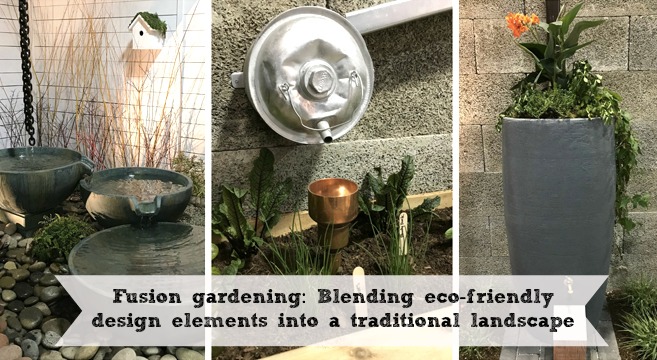This post may contain affiliate links. If you make a purchase through links on our site, we may earn a commission.
One thing I find tricky about gardening trends is that they have way more longevity than, say, fashion, which changes constantly. Pollinators, for example, have been a “trend” for the last several years now, but gardening for pollinators is quite obviously a concept that is not going to go away—well, unless the pollinators do, but that’s a whole other story. This type of mindful gardening, while it may start out as a trend, generally sticks around because it’s in response to an environmental factor. Xeriscaping, eating local, butterfly gardens—these all started as trends, but we’re not going to toss them out and move on. They’re all elements of a garden we should be conscious of. Which brings me to fusion gardening. This buzzword has crept into the latest gardening conversations that I’ve seen in articles, on social media, and at Canada Blooms 2018.
What is fusion gardening, exactly? The way I interpret it is it’s basically a blend of traditional gardening elements (visual design, for example), whilst accommodating several environmental factors—pollinators, rainwater, native plants, etc. A big piece of the puzzle is controlling the flow of rainwater, so it disperses naturally. And then on the other hand, you want to capture some of that water for gardening, so you can reduce the amount of water you get from the tap.
My friend and fellow garden writer Sean James of Sean James Consulting & Design defines fusion gardening more succinctly as “grafting rainscaping with xeriscaping (drought-tolerant landscaping).”
I saw a snarky Facebook discussion, recently, with a back and forth among seasoned gardeners who say they’re already fusion gardening. That it isn’t a thing. Fair argument, I suppose, if you already combine those elements. However, I think new environmental realities, like excessive wind and rain, have evolved what we were doing, even two, three years ago. Capturing rainwater isn’t just about sticking a rain barrel under your eaves.
Most gardeners, being an environmentally mindful bunch, will readily adapt new elements, such as a rain garden, as they determine its practicality for their space. For a landscape designer, it’s an easy way to frame what could be an overwhelming array of gardening ideas under one attractive umbrella. The municipalities surrounding where I live have adopted this term to provide resources to homeowners who want to create their own fusion landscapes. The term has even been trademarked and only certain Landscape Ontario members (our provincial horticultural trades association) who are qualified can design a fusion garden for a client.
One reason that necessitates this expertise is a big component of a fusion garden is capturing rainwater and giving it a place to go. Considering our dense urban and suburban areas, many regions, when subjected to intense rainfall (just look at the damage done in Houston last year), become flooded because everything is concrete. The water doesn’t have anywhere to flow to. This is where rain gardens and bioswales and soakaway pits and permeable pavement (and more!) come into play. And before you mess with a landscape beyond plunking in a few plants, it’s best you consult an expert.
Bioswale, for example, wasn’t part of my vocabulary until the aforementioned Sean James showed an Instagram photo of a Valentine he got from his horticultural apprenticeship students saying, tongue in cheek, that he’s a swale guy. I had to Google it. A bioswale is a landscaping feature where plants and/or compost and/or loose stone (aka riprap, which I also had to Google) are used to filter rainwater as it’s absorbed into the ground. This is an area of fusion gardening I’d like to explore.
I love when I come away from Canada Blooms with ideas I can apply to my own property. Two gardens that featured elements of the fusion gardening design approach included Sean’s, which was designed as part of the province’s Dig Safe campaign (i.e. call before you dig to avoid gas lines, etc.). Sean, who gives talks on fusion gardening, used Ecoraster permeable paving elements from L.I.D. Permeable Paving and Envirolok soil bags for a retaining wall. I love how he snuck in these eco-friendly alternatives to educate visitors to this small space about more than the main message.

On the other side of the show, a company called Parklane Landscapes partnered with Landscape Ontario to create a beautiful garden outlining all the facets of fusion gardening in a clever, elementary way. Here are a few photos.




How will I apply the principles of fusion gardening to my own property? I live almost right under the Niagara Escarpment, so runoff and rainwater, despite a big ravine behind me, inevitably flow through my property in different areas. I inadvertently put one of the raised beds that was built for my book in a particularly wet spot, so I plan to move it and create a rain garden plan for that area. A bioswale plan may factor into this, as well. I’ve been working for a few years now on a front garden that includes hardy plants that can withstand drought (and that don’t mind a good soaking). And because of the excessive use of salt in my municipality, I’ve become more mindful of planting salt-tolerant plants in the areas close to the road. Also, there is a LOT of concrete around my home. Over time, I’d like to introduce permeable paving elements, like those mentioned above.
Note: I plan to come back to this post from time to time to update on any pertinent points I think would add to this conversation, as well as anything I do in my yard. I imagine other elements may be added to fusion gardening over time. I certainly don’t predict that it’s a trend that will disappear. We need these environmentally minded concepts to stick!




Leave a Reply